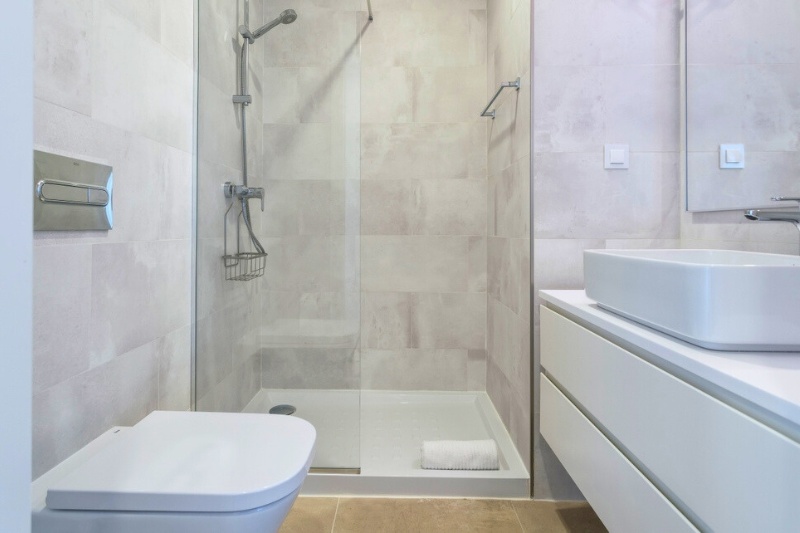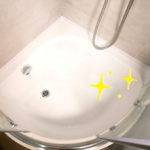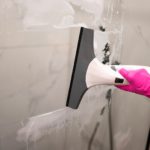Shower cubicles are great for keeping bathrooms dry as they provide a dedicated area for showering while containing the water within its boundaries. However, cleaning these cubicles without getting wet can be challenging.
Fortunately, there are ways to restore your shower’s sparkle without turning yourself into an unintended participant in your own cleaning ritual.
How Do You Clean a Shower Cubicle Without Getting Wet?
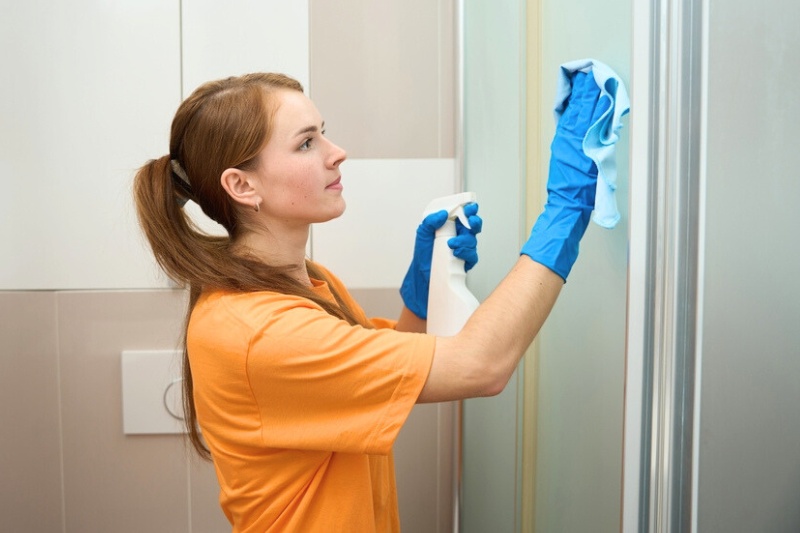
Here are the materials you need, followed by a step-by-step guide:
Materials needed
- White vinegar
- Commercial bathroom cleaner
- Washing up liquid soap and water solution
- Squeegee
- Spray bottle
- Sponges or scrub brushes
- Microfibre cloths
- Old toothbrush
- Bicarbonate of soda
Step 1: Prepare the shower for cleaning
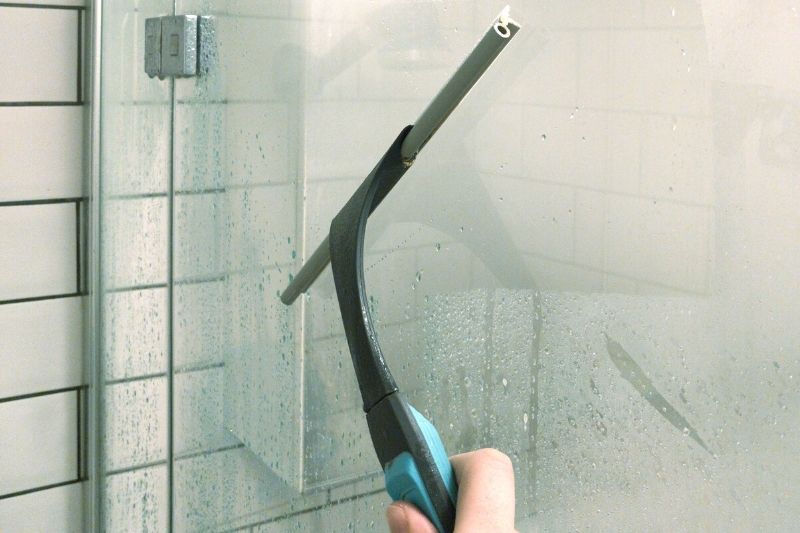
If you want to clean a shower cubicle without getting wet, preparation starts the last time you shower.
Make sure you have a squeegee and run it over all four cubicle walls after showering. This helps remove any remaining moisture and prevent water droplets on the glass doors.
Once out of the shower, leave the extractor fan on and open the windows to encourage any remaining moisture to evaporate from the shower surfaces.
You can keep the windows open until you’ve finished cleaning to reduce fumes from the following cleaning solutions.
Wait at least a few hours after showering to commence the real cleaning process, ensuring any remaining water has a chance to dry.
You can then remove any personal items from the shower area, such as shampoos and conditioner bottles, soap bars, sponges and loofahs, and razors. Dry each item using a paper towel and set them to one side.
Step 2: Dry dust the shower cubicle
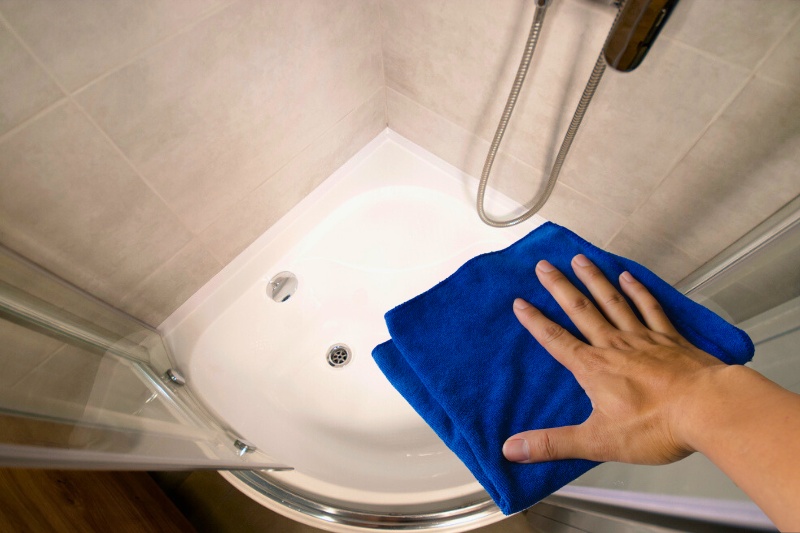
Before tacking limescale, mould, or soap scum that has built up in your shower, you’ll want to remove loose dirt from shower surfaces—for example, dust, hair, and other debris.
You can do this by wiping a dry microfibre cloth over all surfaces. Microfibre clothes can be used on wet and dry surfaces and remove up to 99% of residues on their own.
The microfibre cloth will also pick up any remaining water droplets. Therefore, we suggest you start by cleaning the shower tray so that it is completely dry.
You can then step inside the shower cubicle without getting your feet wet and dry dust the shower from top to bottom.
Step 3: Dry wipe with vinegar solution
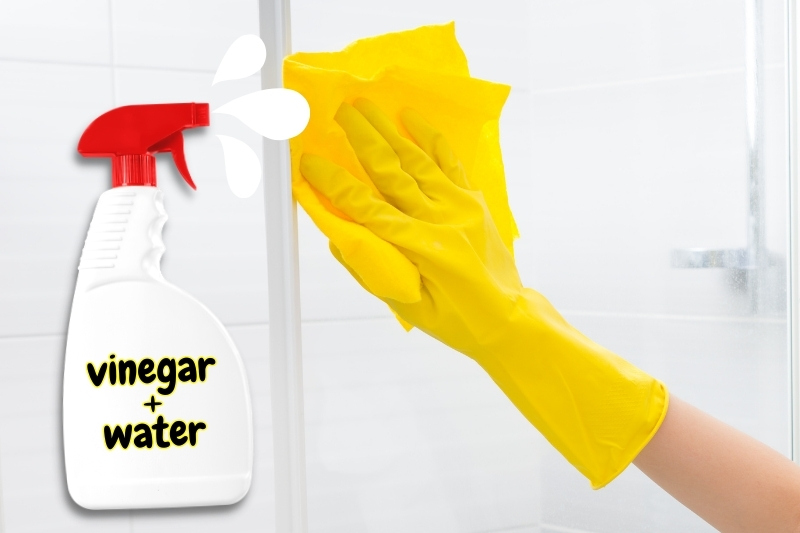
It’s now time to make your cleaning solution using white vinegar and water.
Pour equal parts white vinegar and water into the spray bottle and screw the lid on tightly. Give it a gentle shake to ensure the two liquids have been evenly distributed.
Standing in the shower cubicle, spray the vinegar solution on all surfaces, cleaning the shower screen, walls, and fixtures.
You need to be precise with your aim to avoid getting wet. Then, wipe the surfaces with a clean and dry microfibre cloth or sponge to remove the vinegar solution, along with dirt and grime that has come loose.
When dry wiping your shower with vinegar, start at the top of the cubicle and work your way down to the bottom a section at a time.
By working in small sections, you limit the amount of cleaning solution that will drip into the tray and get your feet wet.
Step 4: Target stains in the shower cubicle
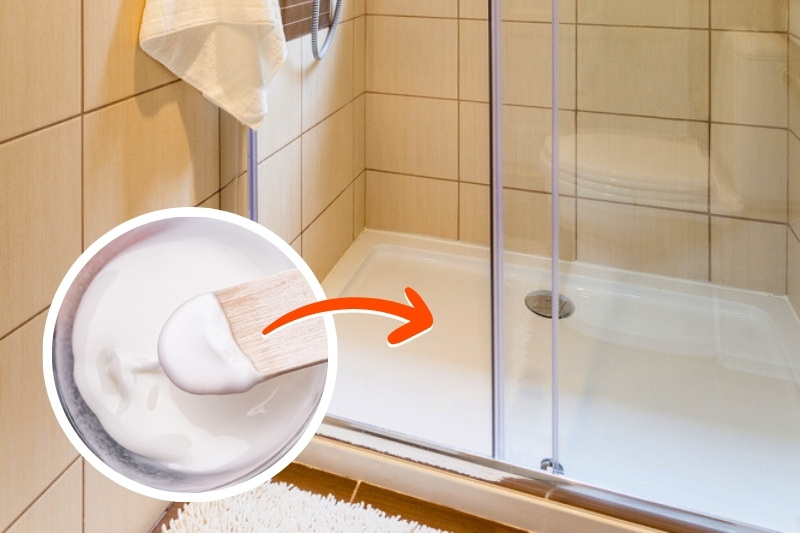
After cleaning using the vinegar solution, inspect your shower for any remaining marks. Any residual stubborn stains need to be treated again using a homemade cleaning paste of bicarbonate of soda (also known as baking soda) and water.
Make the cleaning paste in a small bowl by pouring in bicarbonate powder, adding a small amount of water, and mixing it with a spoon. The texture should be thick and not too dissimilar to toothpaste.
Apply the bicarbonate of soda paste to the shower tray and walls, focusing on stained areas. Let it sit for a few minutes before scrubbing it with an old toothbrush.
If needed, you can use a commercial bathroom cleaner for tougher stains like limescale. Follow the instructions for the specific product.
We recommend purchasing cleaning sprays over products that need to be dissolved in water if you want to clean the shower cubicle without getting wet.
Step 5: Address grout lines

If your shower has tile grout that’s looking a little dirty, now is a great time to clean it.
Cleaning grout in the shower is possible using many different cleaning solutions. You can use your vinegar solution, bicarbonate of soda cleaning paste, or a mixture of water and washing-up liquid.
Take your preferred cleaner and apply it directly to the grout lines. Then, use an old toothbrush to scrub the grout lines and lift dirt and grime.
Work from the top down, and use a damp microfibre cloth to wipe the tiles as you go. This helps to prevent any drips from dirtying tiles you have already cleaned and stops you from getting your feet wet.
Step 6: Rinse the shower surfaces
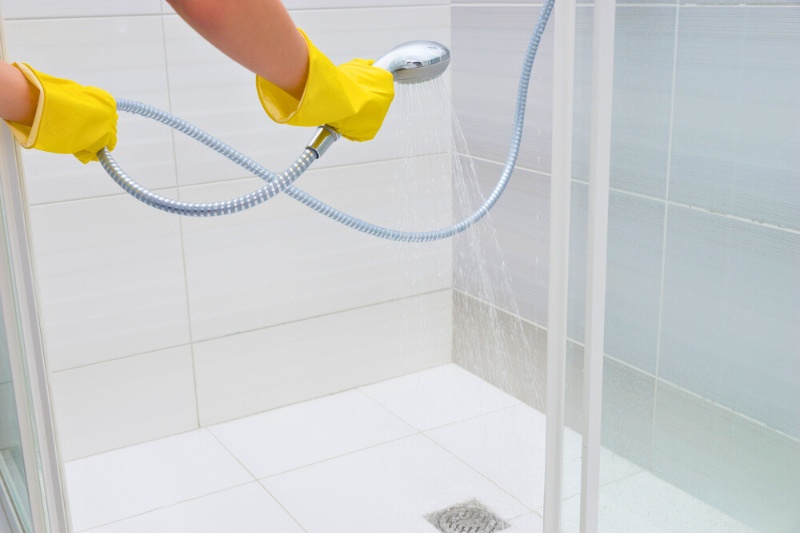
After you’ve cleaned your shower, it does need to be rinsed using water.
Cubicle showers can make this a little challenging without getting wet. They typically have panels that can only be accessed when you’re standing inside the shower.
If you have a detachable showerhead, use this to rinse the areas you can easily reach from outside the shower first.
If there are two doors, close one cubicle door and angle the showerhead through the open door to hit the interior. You can then swap doors and repeat.
Alternatively, try pointing the showerhead down from the top of the shower or in whatever way makes sense with your cubicle design.
If you don’t have a detachable showerhead, you’ll need to use a cup to pour water on all surfaces.
This can be difficult without getting wet, so a good alternative is to clean the shower before you need to shower yourself. Rinse the cleaning remnants off the surfaces first and then shower as usual.
Step 7: Dry your cubicle shower
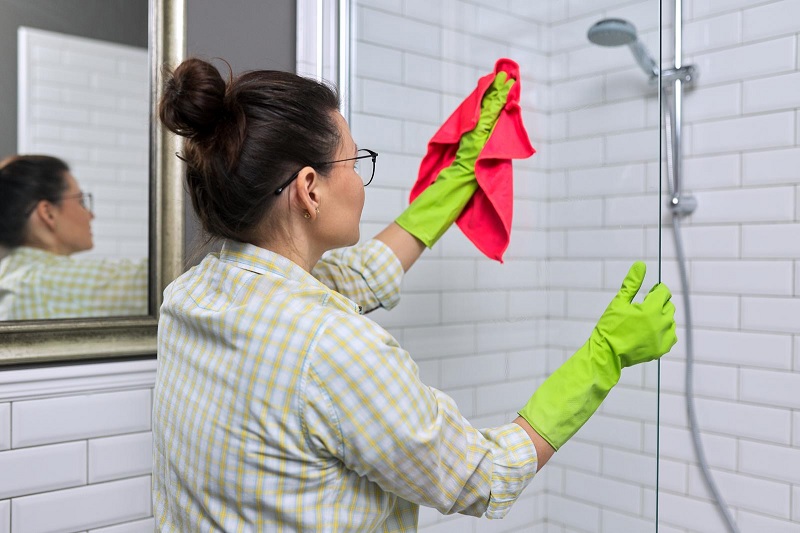
After cleaning, it’s vital to dry all surfaces in your shower. This helps to remove any remaining moisture and prevent water spots from forming.
Moisture also promotes mould and mildew growth, so proper drying is crucial for maintaining a clean, mould-free shower.
To dry the shower, wipe down all surfaces with another clean and dry microfibre cloth. Start with the shower base so that you can step inside without your feet getting wet.
You can then wipe and dry all other surfaces from inside the cubicle. Once you’re done, return any items (shampoo, shower gel, etc.) to your shower, ready for its next use.
Other Tips for Cleaning a Shower Cubicle Without Getting Wet
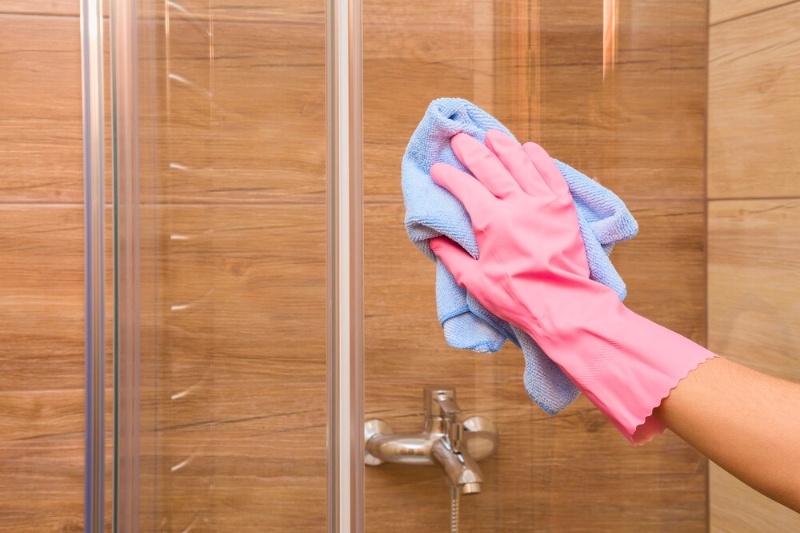
The above cleaning method provides an excellent basis for cleaning shower cubicles without getting wet.
Here are some extra tips and considerations you might want to integrate into your cleaning routine for even better (and drier) results:
- Use long-handled tools: Invest in long-handled scrub brushes or sponges to reach high or distant areas in the shower without getting close to the water or inside the shower cubicle. If you don’t have one already, a detachable showerhead is also worth installing.
- Use dry methods first: Always begin by dry dusting and wiping surfaces with dry materials (we recommend microfibre clothes) before introducing any cleaning solutions. This helps to minimise moisture and removes a lot of the grime and debris.
- Apply cleaning solutions carefully: Spray or apply cleaning solutions strategically to minimise overspray. Direct the cleaning solution precisely where needed, opting for cleaning products in spray bottles rather than dilutable solutions.
- Work in sections: Clean one small section of the shower at a time to minimise your exposure to water, working from top to bottom and drying each area as you go. This allows you to focus on specific areas without getting drenched in the process.
- Wear protective gear: Even with the right tools and techniques, water can easily splash onto your clothes. Consider wearing waterproof gloves and a waterproof apron to protect yourself from water splashes while cleaning. To keep your feet dry, wear flip-flops or jelly shoes.
- Use a squeegee regularly: Invest in a squeegee with a long handle. Use it to wipe down shower walls and glass after every shower to prevent soap scum and water spots. This helps minimise the need for deep cleaning.
- Preventative cleaning: Regularly clean your shower to prevent excess grime buildup. The less buildup there is (soap scum, limescale, mould, etc.), the easier it is to clean the shower cubicle without using water and getting wet.

Hannah has a passion for cleaning. She worked her way around Australia by cleaning hostels in exchange for free accommodation and used her cleaning skills to bag a job as a chalet host for a luxury ski company in France.
